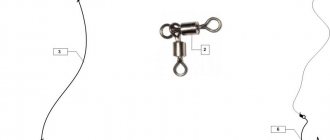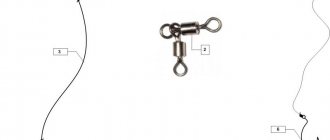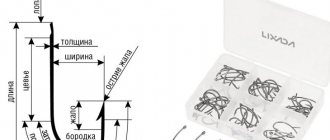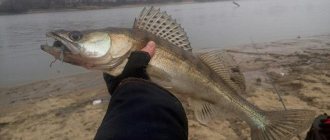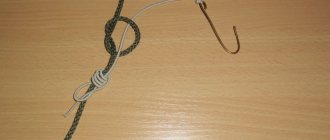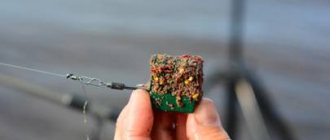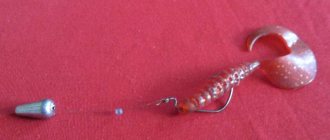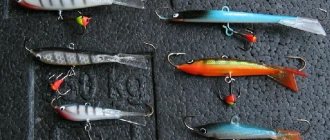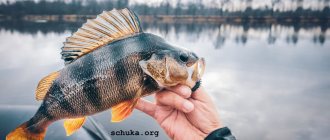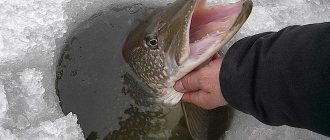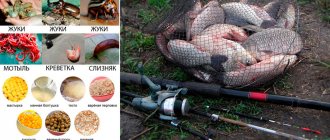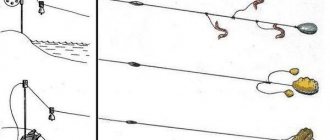Advantages of using a retractable leash when fishing for perch
Perch is caught on a retractable leash almost always and everywhere, which is due to some advantages of this type of equipment:
- Using a leash makes it possible to lead the bait slowly. It is constantly located just above the bottom to avoid numerous snags and to fish difficult snags and vegetation-covered areas.
- For fishing with this tool, a huge number of silicone baits are suitable as attachments: vibrating tails, twisters, worms.
- A bait that is not weighted with a jig head creates intense movement, which attracts perch and other predators, and sometimes peaceful fish. The gear provides the opportunity to fish the lower deep layers of a reservoir with light, small baits.
- A retractable leash makes it possible to vary a large number of types of leads, work at different casting distances, different depths, and fish on bodies of water with different current intensities.
- This type of equipment works great in cold water. Catching perch on a retractable leash is effective in the fall. At this time of year, it is not uncommon to catch large striped predators.
This “smart” tackle often helps out in case of complete lack of bite, when it seems to the angler that there are no fish in the reservoir. If there are no other bites besides light pokes, it’s time to put the heavy jig heads back in the bag and put on a “retractor” with the correct attachment.
Popular fishing techniques
When using the technique of fishing with a retractable leash, you can use different types of wiring. There is no main one, because any technique can show good results if applied in the right situation.
Step wiring can be used. Only it should be smooth, not sharp. With even retrieving, the bait simply drags along the bottom of the reservoir. Quite often, a slow retrieve, when the angler pauses and pumps the rod tip, produces good results.
Pauses are very important for this type of fishing. When the movement stops, the bait begins to either float or sink. Even the most passive perch will pay attention to this and get caught.
The bite when fishing with a lead rig can occur in different ways. It may feel like a sharp jerk or a gentle tug. Sometimes it feels like the fish is nibbling or chewing on the bait. You can hook only when the perch swallows the bait.
With a sudden movement, the thin lips of the perch will tear. When fishing, you should also not forget about this, otherwise the prey may escape. Let the perch get a little tired, and only then pull it out of the water.
Small wobblers - you can and should try. Floating wobblers with a depth of 1-1.5 meters are best suited. Such a wobbler will be able to float up just during the pause, and during reeling it will be able to get closer to the bottom.
What is a perch diverter leash?
There are several classic types of mounting such a leash, which are constantly being improved. Let's look at the general view of equipment often used by spinning fishermen.
The simplest installation is “Moscow equipment”. To make equipment and several carabiners, a 4-10 gram pear-shaped sinker, a fluorocarbon leader, a hook, preferably offset, silicone or other bait.
The simplest equipment is made using the loop method. On the main line of the tackle, usually braided 0.12-0.25 mm, a loop is made, to which a sinker of 4-18 grams is attached. At a distance of 20–30 centimeters from the load, a leash with bait is attached to a loop on the braided line; preferably, it should be made of 0.14–0.29 mm fluorocarbon. Its length is from 50 centimeters to 1−1.2 meters. For equipment, you can additionally use regular or T-shaped swivels.
The sliding and blind versions of the equipment differ in that in the first version the load with the leash can move freely along the main line, and in the second it is attached using a T-swivel or in a loop.
Fishing for perch with a diverter is effective both with traditional types of installation and with new methods of equipment. Fishermen often make changes: they place a foam ball at the hook with the nozzle, which is necessary so that the bait falls to the bottom more slowly; the length of the leash is constantly changed during fishing, performing various manipulations with baits and weights.
Where do they catch
We looked through the fishermen's reports and found points on the map where we caught perch on a retractable leash.
What is a diverter leash?
Retractable leader for perch fishing
When fishing from the shore, a retractable leader is one of the most effective equipment for perch.
Even an inexperienced spinning angler can install a retractable leash on a perch. To do this, simply tie a weight to the end of the fishing line, and above it, at a distance of twenty or more centimeters, attach a leash with bait through a swivel or loop. Weight - from 15 to 30 g, bait - twister, worm or vibrotail about 5 cm long.
In addition to the retractable leash, other types of equipment are used for perch. According to the installation method, the closest thing to the outlet leash is the Drop shot rig, which the perch can take on each retrieve. For fishing in snags and weeds, Texas and Carolina rigs are also used.
Basic spinning equipment:
Retractable leash and other accessories
How to assemble gear for perch fishing with retractable leashes
Tackle for catching perch in this way does not require special rods, hooks, or fishing line. A spinning rod rig with a “diverter” can be made directly on the pond.
Jig rod
Fishing with a retractable leash is more likely to belong to the jig method. It is better to make a retractable leash on a spinning rod 2.5-2.7 meters long, intended for jig fishing.
In large bodies of water, three-meter spinning rods are also used when fishing from the shore. For fishing from a boat, take a shorter rod. The spinning rod test corresponds to the weight of the installation, mainly the weight of the sinker. On average, for cast-off fishing you need rods with a test weight of 8-35 grams. The test depends on the intensity of the current and the depth of the reservoir at the fishing site. The rod should be sensitive enough. This indicator is best provided by fast action spinning rods; you can take medium action rods. They help ensure control of the movement of the bait, high sensitivity and accuracy in long casts.
When choosing a rod blank, the features of the shoreline of the reservoir are taken into account: fishing with a three-meter spinning rod on a river bank overgrown with bushes is unlikely to be effective.
Coil
It is better to use an inertia-free reel that works with thin cords. Suitable sizes 2000−3000. The reel must be reliable, lay out thin line or braid with high quality, and ensure stability. The spinning reel clutch must be working. There should be at least one hundred meters of line on the spool. For such fishing, it is better to choose reels from trusted manufacturers.
Cargo
When fishing with a “diverter”, the weight becomes the most important element of the equipment. A variety of sinkers are used: both special and homemade. Loads usually have an elongated shape, slightly curved, with the center of gravity shifted downwards. Special purchased sinkers are shaped like bananas. They do not cling to the bottom and provide the necessary casting distance for the equipment.
If such weights are not available, you can use ordinary lead drops, which can be found in fishing stores. They also provide casting range, but often get stuck between bottom irregularities at the fishing spot, which in turn leads to frequent loss of equipment. The weight of the cargo used varies. It depends on the depth of fishing and the test of the rod. On average, its weight is 8−20 grams.
Hooks
The fishing hook must be reliable. The small baits used require small-sized hooks, often offset ones. Of the inexpensive models, Kosadaka offset hooks are better suited, they are sharp and durable, suitable for use with even small baits.
fishing line
When fishing, use a main line from 0.12 to 0.25 mm. It is better to use braided wire, as the installation works much better due to its sensitivity. It is much more tensile strength and does not have a memory effect.
It is more difficult to choose the material for the main part of the outlet leash. Its length is usually about 1−1.5 meters. Smaller ones reduce the free play of the bait, larger ones interfere with casting and often get confused. Sometimes it makes sense to shorten them to 40-50 centimeters, the bite increases, but this does not always work and not everywhere.
For the leash, both regular monofilament and fluorocarbon are used. More and more anglers are choosing the latter. This is due to the fact that fluorocarbon fishing lines, due to their rigidity, are much less likely to get tangled and are also less stretchable. This contributes to greater sensitivity of the gear. Such a fishing line has negative buoyancy and does not bend in an arc in the water when inserting the equipment. In addition, fluorocarbon is more wear-resistant and is believed to be less damaged by rocks and other bottom obstacles.
Tackle
Gear for catching perch on a retractable leash is not much different from gear for jig fishing. First of all, you need to choose a high-quality spinning rod, purchase a reliable reel, decide whether you will use regular fishing line or braid, choose swivels, select sinkers and hooks, and of course decide on baits.
Catching perch on a retractable leash is quite specific. Its main specificity lies in the combination of a spinning rod with a fast action and a heavy sinker. Also the use of a huge number of silicone baits in combination with powerful reels.
Such combinations of gear are difficult to imagine in another fishing method.
Spinning
Often, anglers use classic jig spinning rods, consisting of two legs
. I think about the presence of a waterproof coating, a handle made of cork material, special inserts inside the rings and reliable fastening of the reel. Every spinning rod should have these properties.
Here's what the technical characteristics of the spinning rod
for catching perch on a retractable leash, then there are clearly established parameters and values that it is advisable to adhere to:
- For fishing from a boat, use a spinning rod about 2.4 meters long. And when fishing from the shore, choose 2.7-3 meters;
- The average weight of a spinning rod should be approximately 150 grams;
- For complete control of the bait and long casts, use spinning rods with fast and very fast action;
- The spinning rod test should be about 15 - 35 grams (depending on fishing conditions and baits used);
To be on the safe side, you can use combined spinning rods. If there is a high probability of catching pike with perch bait in the fishing area, then it is worth insuring yourself and taking a more powerful spinning rod that can withstand heavy loads.
Although such spinning rods are reliable, they are quite expensive, so most fishermen still prefer jig rods.
Coil
A standard reel for catching perch on a retractable leash is suitable, without additional bonuses. The requirements are the same as for any other spinning reel. The coil must have
:
- mechanism with an endless screw (to ensure cross-winding of cord or fishing line);
- smooth running;
- relatively small mass;
Line or cord
Catching perch on a retractable leash can be done using a classic fishing line or a braided cord, which has recently been rapidly gaining popularity. The diameter of the braid is usually about 0.13 millimeters
. And from personal experience I can say that this diameter is enough when fighting large perch.
Let's take a closer look at the advantages of braided cord and fishing line to make it easier for you to decide which one to use when fishing.
Advantages of fishing line
are as follows:
- Damping the jerks of large fish (due to the ability to stretch);
- The smooth surface of the fishing line dramatically reduces the likelihood of tangling;
- Relatively low price;
Benefits of braid
are as follows:
- A cord of similar diameter can support much more weight than fishing line;
- Thanks to the lack of stretch, you can quickly and accurately hook fish.
But braided cord costs quite a lot, and only some fishermen are willing to pay such a high price for it. Most likely, this is why he has not yet surpassed the fishing line. So the choice is always yours, and think only about how comfortable it will be for you, and not for other fishermen.
Hooks
Often, catching perch on a retractable leash is done using an offset hook.
. And, since the number of fish caught depends on the correct choice of hook, its choice must be approached with special care. In addition to the number of bites realized, the hook also affects the performance of the bait.
I recommend giving preference to hooks from the manufacturers Owner and Gamakatsu, who have been producing really high-quality tackle for many years. And this has been proven by millions of fishermen around the world. The most popular hook models for bass fishing are Gamakatsu Slim Style, Owner J-Hook and Owner RIG'N Hook
.
It is best to stock up on a large number of hooks of different sizes. To always be able to select the appropriate hook for mounting equipment and the size of the bait.
Swivels
Experienced fishermen recommend avoiding the use of various combinations with multiple double swivels. And use one, but a triple swivel. The main thing is that it is black and has a cylindrical or oval base. Pay attention to the mobility of all elements; they must rotate without obstacles.
The smaller the swivel size, the more sensitive the tackle will be.
If you are going to attach the sinker to the main line, you can use one double swivel. No one prohibits combinations of several simple swivels, but they negatively affect the sensitivity of the gear
.
Sinker
Effective catching of perch on a retractable leash can be done using sinkers of different shapes. You can often see fishermen using a rig with a pear-shaped, cone-shaped, teardrop-shaped or classic spherical sinker. The load can be chosen in any shape, the main thing is that it has a ring or swivel built into it for attaching to the tackle
.
The sinker called the “Tyrolean stick” is especially popular, but we will talk about it later, in a separate article, it deserves more attention.
The main task of the sinker on such equipment is to pass through various obstacles at the bottom of the reservoir
, these can be thickets of aquatic vegetation, stones, snags and the like. This is the peculiarity of this gear - to fish where other baits simply get caught.
The weight of the sinker depends on many factors, and usually ranges from 10 to 45 grams. The main factors that influence the choice of sinker weight for a lead are:
- Fishing distance (the longer it is, the heavier the load needed);
- Current speed (the stronger it is, the heavier the sinker should be);
- Perch activity (the smaller the load, the faster the bait is carried);
- Depth at the fishing spot (the greater it is, the heavier the load should be).
Leashes
Catching perch on a retractable leash is done using two leashes. Each of which has its own function and their presence is a prerequisite. Fishermen use:
- Cargo leash connecting the cargo and the swivel;
- A bait leash that connects the bait to the equipment itself.
Usually the weight leash is made of the same material as the main fishing line.
, only the diameter is taken significantly smaller. The length of the leash depends on the fishing conditions and can range from 10 centimeters to half a meter.
The bait leash is made of fluorocarbon fishing line with a diameter of about 0.15-0.25 mm
. Why fluorocarbon? Because it is not visible in the water. Its length depends on the bait used and is usually 30 centimeters.
When the perch is passive, you have to increase the length of the leash, sometimes even up to 1 meter.
Methods for installing a perch diverter leash
There are several main types of installation of a diverter leash for catching perch, the schemes of which differ from each other in the way of attaching the load and the leash itself:
- The traditional version, in which the sinker and leader are tied or attached with carabiners to the loops of the main fishing line. The disadvantage of such equipment is the frequent tangling of the tackle and the rubbing of the fishing line on stones and shell rock. And the hook of a load or hook leads to the fact that the tackle breaks off.
- Leash using a triple swivel. In this version, the swivel connects the main line with the leads from the weight and bait. Each part of the rig is tied to the eye of the swivel. With this installation, it is possible to avoid unnecessary twisting and tangling of the fishing line.
- A leash attached to a loop on the main line using a regular double swivel. This is a slightly improved installation of the first option considered.
- Sliding leash with two swivels. In this case, using a carabiner, a swivel with a leash and a leash with a sinker are installed on the fishing line. The swivel with a leash is able to move freely between the carabiner of the leash with a load and other swivels. In the absence of the necessary equipment elements, it is enough to place two beads on the fishing line as a stopper, and fasten a section of the leash line between them, as in the feeder method of “helicopter” equipment.
When making a diverter installation specifically for perch, it is better to tie the hook firmly. In this case, the action of the bait will be softer and smoother, which will attract curious fish.
Lures for fishing with a retractable perch leash
Installation of this design involves the non-classical use of silicone jig baits.
Both edible and inedible baits are used: twisters, rippers, slugs, worms, vibrotails, crustaceans and many other fancy baits. Of these, all shapes and colors are used for catching perch. The main thing is that the nozzle should not be very large. The most commonly used baits are 2 to 2.5 inches in size. The best way is to use twisters and vibrating tails. The use of spinners and small wobblers is not excluded.
It is better to have baits of various shapes and colors in your arsenal, since the preferences of fish in a separate body of water and certain conditions are difficult to guess in advance.
Vibrating tails and twisters for catching perch
Twisters for catching perch on a retractable leash are an almost ideal bait. Fish are attracted by their naturalness when retrieved in a stepwise manner. After the load falls to the bottom, the twister continues to sink for some time. At this time, perch bites often occur.
Vibrotail is also a bait that is quite popular among perch; the size is chosen depending on the activity of the fish and the intended prey.
Worms, crayfish, and octopuses often become quite catchy, reminiscent of aquatic invertebrate inhabitants in their appearance. They can work much more efficiently than classic twisters, especially when the perch activity is very low. Their color will have to be selected based on the preferences of the fish in the pond.
The general rule: in bright light, it is better to take baits of natural colors, and in low light, when fishing in muddy water, take bright, saturated colors.
An advantage is the buoyancy of the silicone bait, allowing it to smoothly sink to the bottom. The length of the bait should not exceed 3 centimeters.
Other lures in perch fishing on retractable leashes
Lures, spinners and live bait can be used as bait for this type of fishing.
Small wobblers are very convenient in this case. Small floating wobblers or suspenders are suitable for a retractable leash. The latter, when wiring, resemble the behavior of a twister, freezing during pauses. Wobbler models that go very deep are rarely used, but wobblers that provide a shallow diving depth are ideal.
Spoons (spinners, spinners, castmasters) are used much less frequently, but their use can sometimes bring good results.
Lures
Catching perch on a retractable leash involves the use of various types of bait. Their choice is not much different from classic spinning lures for perch. The following can be used as bait for catching perch with a retractable leash:
- actively playing twisters;
- slugs;
- silicone leeches and beetles;
- vibrotails;
- silicone worms;
Now I think it’s worth paying attention to the most popular types of baits for such fishing, these are twisters and vibrotails. Let's take a closer look at what conditions and what types of baits are best to use.
Twisters and vibrotails
Among other silicone baits (worms, slugs, bugs and frogs), twisters and vibrotails simply have no equal in terms of catchability. We can definitely say that twisters and vibrotails are the most catchy baits for catching perch on a retractable leash.
.
Be sure to choose soft silicone baits
. A bait made of soft silicone will play perfectly on a slow retrieve. But, if the vibrating tail is rigid enough, then for normal play it will require aggressive wiring, which the perch does not always like.
If you nevertheless purchased a hard bait, then you can soften it as follows: hold the twister or vibrating tail over boiling water for 2-3 minutes, and then place it on a flat surface and wait until it cools down. Such a bait will play much better, but will last much less
.
The choice of bait size depends on many factors, the main one being the time of year. Most often, fishermen use silicone baits about 2-5 centimeters long.
. For autumn fishing, take larger baits; for summer and spring fishing, you need to take smaller baits.
Regarding the choice of color, the range is very wide and the color can be very diverse, sometimes even very exotic. There are many rumors among fishermen that perch prefer red and orange baits.
. There are also a lot of different edible silicone baits, or with the addition of attractants, but that’s a different story.
For such baits, a hook No. 8–9 will be sufficient.
, as mentioned above, it must be offset and there are reasons for this. By the way, pay attention to the fact that the distance from the tip to the forend should be quite small. Otherwise, hooking will be very difficult.
Other baits
But catching perch on a retractable leash does not only involve the use of silicone baits. Fish are also excellently caught with other baits that are familiar to all fishermen, but they are less popular in this type of fishing. Let's talk a little about each of them.
Small spinners
. They cannot replace twisters, but very often they give anglers an advantage in spring fishing. Thanks to the wide amplitude of vibrations, the perch reacts well to them.
Small wobblers
. This is a lure that all anglers need to try. Give preference to wobblers with positive buoyancy and a depth of about 2 meters. Then the bait will float up and sway during pauses, and during the retrieve it will dive and create oscillations.
Silicone crustaceans, worms, squids
. They are used extremely rarely, since they are not included in the diet of local perch. Still, our perch is more accustomed to hunting small fish than squid. But sometimes it’s worth trying this exotic solution.
Features of using the “retractable leash” equipment: fishing technique and tactics
The essence of fishing in this way comes down to the fact that tapping the weight on the bottom and playing the bait attracts fish. When fishing, step-by-step wiring works best, which gives the bait a certain intensity in the game. When retrieving in stages, the bait is lifted from the bottom by jerking the rod or by accelerating the winding of the reel, then again it is allowed to fall to the bottom. You can use double undermining by swinging the tip of the rod. With active biting, you need more aggressive wiring, with passive biting - soft and smooth.
There are other types of wiring:
- Uniform wiring is used a little less frequently than stepped wiring, but is sometimes just as effective. With this type of wiring, you can add swaying of the rod and take short breaks.
- Dragging along the bottom is also rarely used. With this type of wiring of the outlet leash, the load of the equipment moves slowly along the bottom with short stops. The bite occurs most often when the rotation of the reel slows down.
You can experiment and use various elements of different types of tackle wiring, change the size and installation of the leash equipment.
When fishing in reservoirs without current, all existing equipment and various types of wiring are used. In the lake you don’t have to choose the direction of casting. It doesn't matter if it's upstream or against it. There are no strong currents on the lakes, so on stagnant bodies of water you just need to throw the tackle at the point that seems more promising.
Due to the lack of current, all animation of a silicone or other bait falls entirely into the hands of the spinning angler. And its animation in a still body of water needs to be given more attention, using different types of fishing gear. A technique that is effective on a lake is a long-term play with bait in one place, which cannot be used on rivers.
The attack of the perch occurs mainly at the moment of pause. When biting, the hook should be immediate, but not strong. A very strong hooking tears the lips of the fish, and consequently leads to loss of catch.
Stop and go
The leash fits well into the main practices of perch fishing and occupies a dominant position. For example, stop and go bait. This is a universal type of bait used in any body of water, except when the bottom is covered with silt. The algorithm for using the stop and go method is as follows:
- They cast and wait for the bait to reach the bottom.
- They begin to drag the sinker along the bottom.
- There are sporadic pauses along the way.
- They pull the perch ashore and place it in a cage.
During pauses, the bait stops abruptly. It is at such a moment that the perch grabs its prey. It would seem, well, an exact copy of ordinary fishing, but this is not so. Everything is somewhat more complicated.
It is necessary to determine a wobbler suitable for catching perch using the “stop and go” method. As practice has shown, a suspender that is predicted to dive 1 meter from the water surface or more has good characteristics. In the fall, dexterous fishermen, with minimal time and physical effort, return from reservoirs with a decent catch.
Seasonal nuances of using diverter leashes
Catching perch on a retractable leash has its own characteristics at different times of the year.
- In the spring, during the zhora period, the diverting leash can amaze with its effectiveness. Different rig options are equally effective at catching perch in different conditions. At the end of spring, when aquatic vegetation appears, it is advisable to equip the leash with offset hooks and a streamlined weight resembling a Tyrolean stick.
- Summer is not the most catchy time for a diverting leash. However, even at this time of year it gives its results. During this period, perch feeds in the upper and middle layers of water; activity manifests itself in the morning and evening hours. It is especially productive to use a diverting leash in the summer on cloudy, cool days, when perch activity is quite low.
- In the fall, fishing for perch on a retractable leash is especially productive. During this period, you need to experiment with attachments and wiring. When fish activity is low, the fishing speed should be reduced. If the bite is normal, it is necessary to use fast, aggressive options.
Under what conditions should it be used?
The diversion leash can be used both in still water and in places with fast currents, in depths and shallows, in areas with a clean bottom and in snags.
It is best to fish in the morning and evening, when the predator comes out from its hiding places to hunt. The best places for catching perch are the boundaries of currents, riffles, drop-offs and edges. The bite in these places continues almost until autumn. As the weather gets colder, the fish move to deeper places. Now perch can be caught on the lower parts of near-channel edges, on dumps. It is often found at the exits and entrances to pits, in long ditches with medium depth, and rare snags. In general, perch can be caught in large water areas with uneven bottom relief and depth differences.
Fishing with a retractable leash is relevant when fishing over long distances, when a small bait cannot be sent over a significant distance. In large water areas, it helps to quickly explore unfamiliar places and detect massive concentrations of this striped predator. It helps when fishing the depths. On small rivers, the leash does not always meet the expectations of anglers.
Fishing from a boat with a diverter is not always convenient, but it can also bring results when the perch bite is weak.
The diverting leash is an effective, universal and simple tackle that works on inactive fish and on active predators. It always attracts the attention of the fish and allows you to stay with the catch where other equipment does not bring any results.
Perch on a lead leash: features and subtleties of fishing
Perch on a retractable leash is a popular and exciting type of fishing, which is distinguished by its versatility and efficiency. Today, fishing for striped robber with this spaced rig has many fans who use it on rivers, lakes and reservoirs. Everywhere, catching perch on a retractable leash shows stable results and allows you to leave the reservoir with a rich catch.
Beginning fishermen, having seen the success of experienced spinning anglers, are wondering how to catch perch on a retractable leash? However, independent steps do not always bear fruit; you have to make efforts to achieve sustainable success. It’s better to master this spaced-out rig with the help of a seasoned colleague who will tell you and show you many of the secrets and nuances of fishing.
The retractable leash, like all other fishing methods, has its advantages and disadvantages. They determine the scope of application of the equipment and some of the subtleties of fishing. The main advantages of the tap are:
- Universalism. The equipment can be used in different bodies of water, at any depth, in diverse fishing conditions.
- All-season equipment. Tackle for catching perch on a retractable leash works all year round. It is used in the spring, throughout the summer and throughout the fall. On non-freezing sections of rivers, diversion is the number one method for fishing for striped robber and other predators.
- The retractable leash is suitable for hunting different-sized fish. He comes across a small sailor and a seasoned humpback. It all depends on the chosen fishing location and the size of the bait used.
- Relative cheapness of the method. Installing a diverter leash for catching perch does not require expensive elements. The gear used is also inexpensive. Many fishermen use a jig kit, which can be easily reconfigured for fishing with this spaced-out equipment. The correct spinning rod for perch is discussed here.
- Easy to learn. The retractable leash does not require ornate animation techniques. The main fishing options can be studied during your first fishing trip and can be used productively in the future.
The main disadvantage of the outlet is its bulkiness. It is inconvenient to handle in an inflatable boat or while on an overgrown bank of a reservoir. Because of this, some fishermen completely refuse to use this spaced equipment, choosing classic methods - jig, twitching, microjig and others. Interesting article: how to catch perch with a spinning rod.
The perch tackle is mounted with a retractable leash directly on the pond. This takes some time. The presence of various elements reduces the strength of the equipment, which, when fishing in difficult conditions, leads to frequent breaks.
Seasonal features of using a diverter leash
The diverter leash rig for catching perch can be used year-round on any reservoir. Each season leaves its mark on fishing tactics. It depends on the fishing conditions and the behavior of the striped robber. Advanced spinning anglers are well aware of all the intricacies of each season, so they achieve success regardless of the weather and the mood of the predator.
Catching perch on a diverting leash in the spring begins from the moment the water bodies are cleared of ice cover. You should look for striped fish at medium depths in places with uneven bottom topography. He is pressed to the bottom and inactive. Therefore, this spaced rig shows decent results, since it is adapted for a passive predator.
Impressive catches are achieved in early summer on medium and large rivers. In June, perch actively responds to a retractable leash and prefers this equipment more than others. Even a universal microjig loses in efficiency, especially on riffles with depths of two to five meters.
At the beginning of summer, the striped robber concentrates on the bottom strewn with shell rock. The retractable leash allows you to maintain the integrity of the equipment when guiding along a sharp shell, and the leisurely feeding and slow dragging of the lead sinker along the ground allows you to tempt a sluggish and apathetic perch to grab it.
Productive fishing for perch on a diverting leash in the summer on rifts, dumps and edges lasts until the end of August. Then, as the water cools, the fish migrate deeper. The predator now occupies the following locations:
- The lower part of channel edges and dumps.
- Entry and exit from pits.
- Extended ditches with medium depths.
- Sparse snags.
- Deep riffles.
In these places, the use of a diverting leash is most justified. Perch can also be caught near hydraulic structures and in vast water areas with uneven terrain and average depths.
Catching perch on a leash on a lake has its own specifics. Due to the lack of current, light weights have to be used. This affects the casting distance; it is not always possible to catch promising points. You have to look for a middle ground, choosing the weight of the equipment that will allow you to carry out optimal wiring and not lose the range of the equipment.
This spaced-out rig does not outperform other methods of hunting striped robber everywhere. It is relevant at long distances, when a small silicone bait needs to be sent over a considerable distance. The same situation helps when fishing at great depths. Perch spinners, miniature wobblers and micro-oscillators are inferior to the spinner and turn out to be ineffective.
On small rivers, small lakes, quarries, ponds or toad grasses, the diversion does not live up to the expectations. In these conditions, it is better to use banal ultralight and miniature artificial baits.
In vast water areas of reservoirs, a diversion leash allows you to quickly and productively explore unfamiliar locations, detecting a concentration of striped robber and tempting it to attack the bait. Despite the inconvenience of fishing from a boat, anglers manage to achieve decent results.
A retractable leash is a universal equipment that works against passive fish and active predators. Regardless of the mood of the perch, the outlet always attracts his attention and forces him to grab a passing twister or vibrotail.
It is important for fishermen to know not only how to make a diverting leash for a perch, but also what kind of wiring to do in a specific situation, provoking a bite from a predator. There are several basic techniques for feeding equipment that a beginner needs to master:
- Uniform wiring at moderate speed. This is a basic animation that allows you to catch a striper in any situation. It is carried out due to the slow monotonous winding of the fishing line. In this case, the sinker should continuously drag along the bottom, breaking away from it for a split second.
- Posting with pauses. Performed on the basis of the previous one. Periodically, the angler stops the rotation of the reel handle. By varying the duration of the pauses, it is possible to find the key to an intractable perch. During long stops, the length of the outlet leash for the perch should be at least a meter. Pauses can be taken randomly or at a certain interval. In general, the nature of the animation is determined empirically on the spot, taking into account many factors.
- Super slow wiring. It is necessary when the perch is extremely passive and refuses to take the bait, only occasionally butting it. It is performed as a basic option, only with a very slow winding of the cord.
- Fast bait delivery. It is used in vast unfamiliar and unexplored locations for active perch, when it is necessary to determine the most catchable points where the concentration of feeding perch is high in a minimum time.
